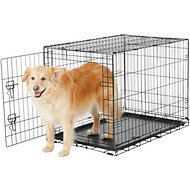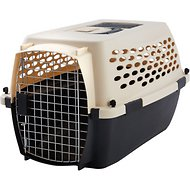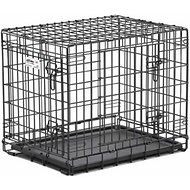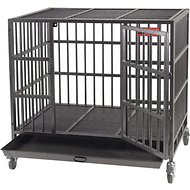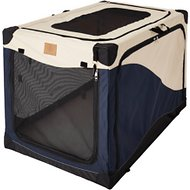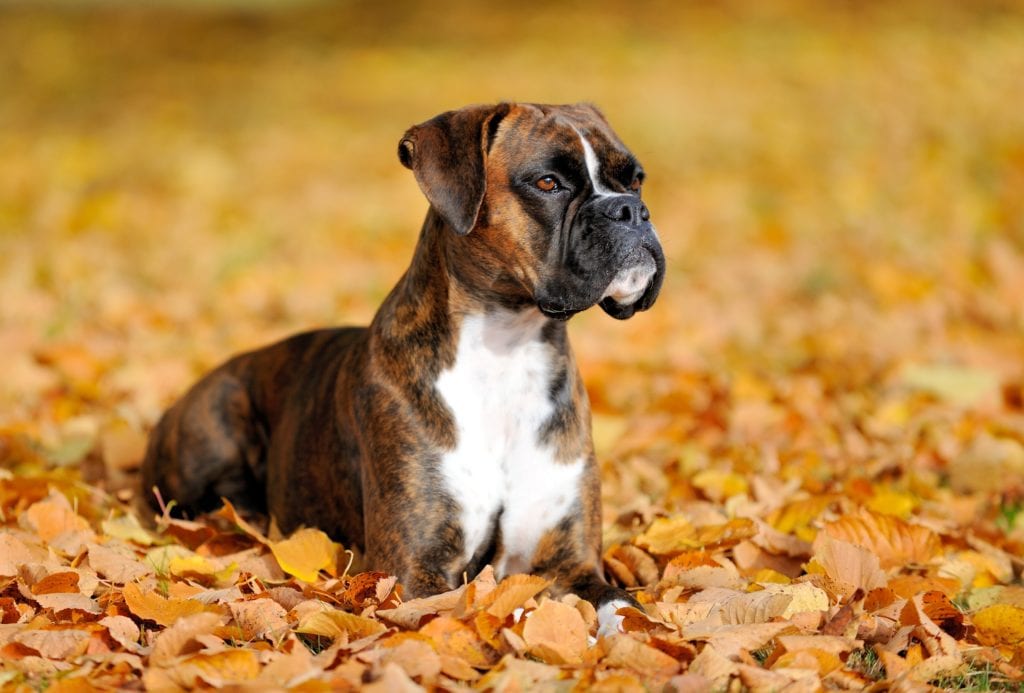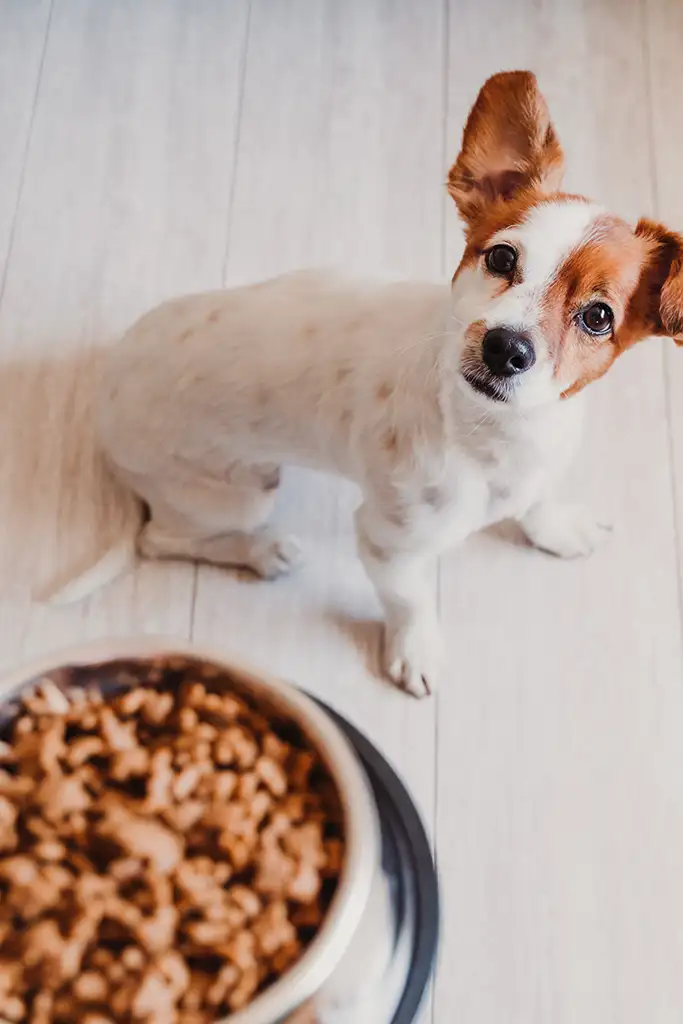5 Best Boxer Crates: Our 2024 Boxer Crate Size Guide
Quick Guide
Boxers are one of the top registered breeds in America and worldwide, thanks to their huge personalities, intelligence, and family-friendly demeanor. The modern Boxer may have been bred from fighting dogs, but everyone who owns a Boxer knows that they’re just big softies at heart!
But whether you have an older Boxer that needs to be crate trained, or you’re the proud new owner of a new Boxer puppy, you may be wondering which type of crate is right for your furry friend. With so many different styles and sizes on the market, it’s not always easy to choose.
Well, we’re here to help. In this article, we’re going to discuss everything you need to know about Boxer crates. From choosing the right size of crate and suggesting a few top products, to crate training tips, FAQs and much more, we’ll discuss everything that you need to think about when shopping for the perfect Boxer crate. Read on, and learn with us.
What is the Best Dog Crate for a Boxer?
Popular Types Of Crates For Boxers
Before we begin, let’s quickly discuss the most common types of dog crates, so that you understand your options when shopping for a Boxer crate.
- Folding wire crates – Folding wire crates are the most popular type of dog crate for a few good reasons. First, they are very simple, affordable, and cost-effective. They also are usually portable and collapsible, so you can stash them away or move them easily when you want to. Another big reason these crates are popular is that they usually come with a wire divider panel. This divider panel separates a large crate into a smaller one, allowing you to use the same crate as your puppy grows. This saves you quite a bit of money, since you won’t have to buy multiple crates.
- Heavy-duty crates – Heavy-duty crates usually use strong steel bars or wire, and are built specifically to contain strong dogs which have a tendency to escape. Folding wire crates are not escape-proof, and a determined dog can usually force its way out of its crate. This is not the case with heavy-duty crates, which are not bendable and have strong, secure latching mechanisms. While they are ideal for dogs that try to escape, they are usually very heavy, bulky, and expensive.
- Soft-sided crates – Soft-sided crates are often used for travel and outdoor activities, and are made of a strong canvas or nylon material stretched over a metal frame. They usually include vented windows and doors to keep your Boxer comfortable. However, they should not be used to crate train a dog, because they can be easily torn and chewed through. It’s best to use a soft-sided crate only once your dog has become familiar and comfortable with its crate.
- Plastic portable crates – These are sometimes called “air carriers” because they’re the preferred way to transport dogs for airline travel. Made of a strong plastic material, they usually have a wire door and vents, and are very durable, making them great for traveling. However, they are usually smaller and narrower than traditional crates, making them less-than-ideal for full-time use at home.
Depending on your Boxer and the activities and traveling you do with your pup, one or more of these above crate types may be right for you.
How to Determine the Correct Boxer Crate Size
A properly-sized crate is essential for potty training your boxer. The idea behind crate training is that dogs like to have a personal “nest” or “den” where they can relax – and they are unlikely to try to pee or poop in their own area.
If your dog’s crate is too big, though, it may sneak to the corner, do its business, and then go back to its bed – which defeats the purpose of crate training.
A crate that’s the right size will allow your Boxer to sit, lay down and turn around comfortably. However, it won’t be big enough for your pup to use the bathroom away from its personal space.
Most Boxers will fit perfectly into a 42” crate, while some smaller Boxers may be better off in a 36” crate. To find out which size is right for your dog, you can measure it with the following steps:
- Measure your Boxer from the tip of its nose to the end of its tail and add 2-4” to calculate the proper length of the crate
- Sit your Boxer down and measure from the top of its ears to the ground to determine the proper height of the crate
- Measure your Boxer’s body and add 4 inches to this measurement to determine the proper minimum width of the crate
Overall Best Dog Crates for Boxers
| Our 2024 Picks: Best Dog Crates for Boxers | |||
Frisco Fold & Carry Single Door Dog Crate
|
CHECK PRICE | ||
Frisco Plastic Kennel, Almond & Black
|
CHECK PRICE | ||
MidWest Ultima Pro Double Door Dog Crate
|
CHECK PRICE | ||
ProSelect Empire Dog Cage
|
CHECK PRICE | ||
Precision Pet Products Soft Sided Crate
|
CHECK PRICE | ||
Frisco Fold & Carry Single Door Dog Crate
Key Features:
- Comes with plastic pad, divider panel and carrying handles
- Collapsible for transportation and storage
- Strong, secure dual latch design
- Rust-resistant with black electro-coat finish
Overall Best Crate For A Boxer: This product from Frisco is our top overall choice for a Boxer crate. It offers an extremely good value, especially with the included divider panel that allows it to be used for Boxer puppies of all ages. While it won’t hold up to determined escape artists, it’s a great option for crate training, and our top overall pick for the best Boxer crate.
Pros:
- Great value
- Simple and easy to use
- Foldable for storage
Cons:
- Won’t hold up to canine escape artists
- Difficult to assemble
- Metal wire is not very bend-resistant
Frisco Plastic Kennel, Almond & Black
Key Features:
- Approved for most major airlines
- Sturdy and lightweight plastic shell
- Durable double-latching mesh door
- Plenty of ventilation
Best Travel Crate For A Boxer: If you need a crate for air travel or car travel, this product from Frisco is a great choice. It’s approved for air travel by most airlines, and features a lightweight design with carrying grooves, plenty of ventilation, and a secure wire mesh door.
Pros:
- Great for airline travel
- Lightweight and easy to store
- Durable
Cons:
- Not very chew-resistant
- Does not come with a removable mat
- Plastic hardware may strip over time
MidWest Ultima Pro Double Door Dog Crate
Key Features:
- Reinforced wire for strength
- Two doors
- Comes with roller pads to protect floors
- Includes plastic pan, carrying handles, divider panel
Best 42 Inch Crate For A Boxer: If you’re looking to spend a bit more money and get a heavier-duty wire folding crate, this product from MidWest is a great option. It’s made with reinforced steel wire and can hold up to more abuse than most wire crates. It also has two doors, which provide it with more versatility when it comes to the placement of the crate in your home.
Pros:
- One of the strongest wire folding crates on the market
- Comes with plenty of accessories
- Double doors for easy entrance and exit
Cons:
- Can still be bent and damaged by strong, escape-prone dogs
- Tends to rattle when moved and in the car
- Some customers report bent components due to minimal packaging protection
2 More Boxer Crates
Need more options? Wondering what other Boxer crates are out there? Here are a few more top picks for the best Boxer crates in 2024.
ProSelect Empire Dog Cage
Key Features:
- Built with 0.5” thick 20-gauge steel
- Strong double-latch system
- Heavy-duty welds for maximum protection
- Big enough for even the largest Boxers
If your Boxer tends to bend and escape other crates, the ProSelect Empire Dog Cage may be a great option for you. It is very expensive, but it’s truly impossible to escape, with thick, high-grade steel, reinforced welds, and latches that cannot be moved or accessed by your dog.
Pros:
- Completely escape-proof
- Wheels make it easy to move
- Removable tray for easy clean up of water, food, and “accidents”
Cons:
- Extremely expensive
- Very heavy and bulky
- May rust in damp environments
Precision Pet Products Soft Sided Crate
Key Features:
- Plenty of ventilation
- Comes with carrying handle and case
- Reinforced seams and corners for durability
- Includes rear accessory pockets and water bottle holder
Soft sided crates are great for car travel and outdoor excursions like picnics and camping trips, as long as your dog is properly crate-trained. This crate from Precision Pet Products is perfect for Boxers, with plenty of vents, an attractive and easy-to-clean design, and a sturdy metal frame that prevents it from collapsing on your pup.
Pros:
- Lightweight and easy to transport
- Simple to fold, unfold, and set up
- Dark, comfortable, den-like environment
Cons:
- Only usable for crate-trained dogs that won’t scratch, tear, or bite the fabric
- Relatively short height
- Zippers can become loose unless locked
5 Tips For Crate Training A Boxer Puppy
If you’re training a Boxer puppy for the first time, and you would like some helpful tips and tricks that can help you throughout the process, we can help. Here are a few top tips for crate training a Boxer puppy that are sure to help you as you potty train your dog.
- Make your puppy’s crate comfortable and familiar – When you first introduce your dog to its crate, it may be wary of it, and it won’t want to stay inside. One way to help deal with this is to make your Boxer’s crate feel more comfortable and familiar. Using one of its favorite blankets to line the crate and putting some of its preferred toys inside, for example, can help it get used to the crate. It also may help to put your dog’s crate where its bed used to be, so that its habit of going to its bed is replaced by going into its crate. The more comfortable and familiar your dog’s crate is, the more likely they are to want to use it.
- Keep your Boxer’s crate in an out-of-the-way location – Think of a crate like your dog’s bedroom. You wouldn’t want people tramping around and making noise in your own bedroom, and your Boxer doesn’t want that, either. We recommend finding an area of your home that is out-of-the-way, so that your Boxer can have its own special place to rest and relax.
- Take things slowly, and don’t rush crate training – At first, your Boxer may not even want to go into its crate. Forcing your puppy into its crate before it’s ready is counterproductive, and can result in feelings of fear and negativity. If your dog is only comfortable in its crate for a few minutes at a time, that’s okay. Leave it in until it starts to whine, then let it out. As time goes on, you’ll be able to expand the amount of time you leave your dog in its crate – from 5 minutes to 10 minutes, to a half-hour, and beyond. It takes time, so don’t rush things. As your Boxer gets more used to the idea of crating, it will become more comfortable with it – and eventually, it will actually want to use its crate!
- Never use crating to punish your Boxer – A dog crate should be your Boxer’s cozy, personal den. It should be a place of comfort and happiness – not a punishment. If you punish your dog by crating it, your Boxer will start to associate feelings of negativity with its crate, which is not a good thing.
- Don’t make a big deal out of your arrival or departure – Once you’ve started crating your dog for longer periods of time, make sure you crate it about 20 or 30 minutes before you leave the house, and then let it out 10-20 minutes after you get home. Don’t make a big deal out of coming home or leaving, or get too excited. Taking these steps will help your dog get used to the idea of being crated when you’re at home – not just when you leave. This can help with separation anxiety and feelings of nervousness related to you leaving the house.
If you need more tips, we recommend doing some online research about proper crating methods, or consulting with a local dog trainer or animal behaviorist!
FAQs About Boxer Crates
Got questions about crating your Boxer? We’ve got answers. Take a look at a few common FAQs below.
- How long should I crate train my Boxer puppy at night? You can keep your Boxer puppy in its crate all night, but you will need to take regular bathroom breaks about every 3 hours until your puppy is about 9 weeks old. Puppies simply cannot “hold it” all night without an accident. Once your Boxer puppy is 9-12 weeks old, you can usually get by with a single bathroom break, about 4 hours after you go to bed. Then, over the next few weeks and months, you can start extending this time – until you finally get to a full 7-8 hours, and you no longer have to let your Boxer out for a bathroom break at night.
- Why can’t I keep my Boxer’s collar on while it’s in its crate? Collars can pose a strangulation risk if they’re caught on any part of the crate. For this reason, you should never put your Boxer into its crate while wearing a collar, particularly if nobody will be at home for a long period of time.
- Is crating cruel or harmful to my Boxer? Not at all! When done properly, crate training helps with housebreaking and chewing, and it’s not harmful at all. In fact, it’s beneficial, because dogs like having their own “den” where they can relax and feel safe and at home.
- How long can I keep my Boxer in its crate? Puppies should not be left in their crates for more than about 4 hours at a time, at a maximum. Adult Boxers should be let out after about 8 hours. Remember, your Boxer needs time to explore, relax, stretch its legs, and have fun – just like you!
- How can I stop my Boxer from chewing on its crate? Throwing a few chew toys into the crate can help. Most dogs would much rather chew on a strap of rawhide than metal bars or plastic crates. You can also buy anti-chew spray from your local pet supply store. This spray tastes nasty to dogs, but is harmless. Spraying it on the cage will prevent your dog from chewing. A bit of behavioral training can also help. If you see your dog chewing on its crate while you’re at home, just say “NO” firmly, and gently nudge your dog away from the area it’s chewing. Over time, this will help your dog learn not to chew.
We hope this information has been helpful, and answered some of your questions about crate training your Boxer!
Conclusion
Choosing a great Boxer crate for your dog should be a snap with this guide. Take another look at a few of our top crate recommendations and think about your dog’s needs, and you’re sure to make the right choice.



